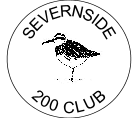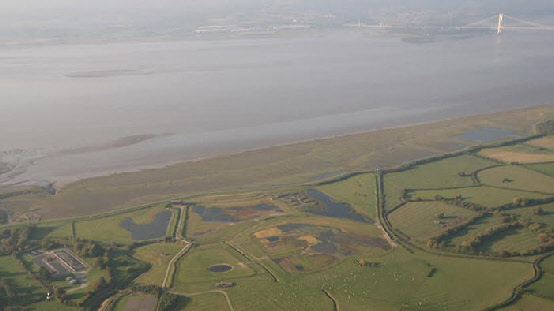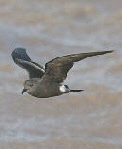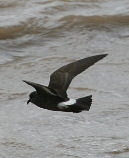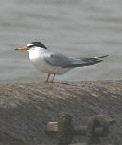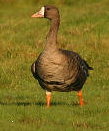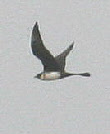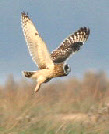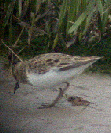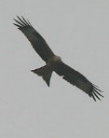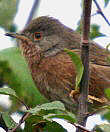WADERS
High tide visits are essential for close views of waders - an hour either side will give the closest views (click here for link to high tides at Avonmouth). The light conditions are better in the morning than the afternoon when everything can be silhouetted. The main wader roost, depending on disturbance, during the spring and autumn is at Severn Beach. Careful scrutiny of the roost can locate small numbers of Little Stint, Curlew Sandpiper and Sanderling. The wet areas of Northwick Warth including the recently created (2011) freshwater pools on the Pilning Wetland now attract and hold some decent waders in the autumn such as Ruff, Greenshank and Wood Sandpiper. Cold winters can produce thousands of Dunlin, several hundred Turnstone with the now occasional Purple Sandpiper.
Rarities have included; Long-billed Dowitcher, Semipalmated Sandpiper, American Golden Plover(2), Lesser Yellowlegs (2), Dotterel, Stone Curlew(4), Pectoral (10), White-rumped (5), Buff-breasted (3), Broad-billed and Terek Sandpipers, Black-winged Stilt (3), Collared Pratincole, Kentish Plover (6), Temminck’s Stint (6), Grey and Red-necked Phalaropes.
Pilning Wetland and Northwick Warth © John Sparks
WILDFOWL
Despite the proximity of Slimbridge WWT, both White-fronted Geese and Bewick's Swan are scarce winter visitors. The most frequent visiting goose is Canada Goose with flocks of up to 650 recorded followed by Greylag, Barnacle and dark-bellied Brent but still in small numbers. Shelduck are present throughout the year with small parties of young present from early June. The most obvious winter species are Mallard, Wigeon, Teal, Shoveler and Gadwall. The freezing of inland waters usually produces a rapid increase in the number of species. Sea ducks remain scarce but Eider and Common Scoter are seen in varying numbers. Garganey are now seen regularly in the spring, most often on Pilning Wetland at Northwick Warth
SEA BIRDS
Severnside is the premiere site in Avon for obtaining close views of sea birds. A detailed paper has been published in 2000 Avon Bird Report, describing the occurrence of all the species. The following is a brief guide. West or South west gales will produce "something" at any time of the year (click here and look for sea area Lundy in the shipping forecast ). The best locations are all south of the Second Crossing. The birds are best seen two hours before and one hour after high tide. The birds are usually seen close to shore. The most frequent seabirds are Kittiwake and Fulmar which can be seen in strong wind throughout the year. Leach's and Storm Petrels are almost annual in varying numbers. The best place to observe these masters of the waves is in "burger bar bay", the stretch of water immediately south of the Second Severn Crossing.
Manx Shearwaters and Gannets are most likely to be seen in gales during the summer months. Guillemots are more frequent than Razorbills, Little Auks more so than Puffin but there are three recent sightings of the latter. Arctic and Great Skuas are annual, Pomarine Skua is seen more often than Long-tailed Skua. Strong winds in November 2009 produced exceptional rarities in the form of a presumed Black-bellied Storm Petrel and Pacific Diver. Other scarce storm driven species include Divers and Sabine's Gull. There have been three records of Cory's Shearwater and one record each of Sooty and Balearic Shearwater.
SPRING TERN MIGRATION
During the spring in weather associated with east or north east winds, exceptional numbers of Terns along with Little Gull, Skuas, Bar-tailed Godwits and Whimbrel can be watched migrating upriver into the head wind. This phenomenon can vary from year to year even with similar weather patterns. Hundreds of Common and Arctic Terns, dozens of Black Terns and a smaller number of Sandwich and Little Terns can be seen over two or three days as migration peaks (usually the first few days of May).
OTHER BIRD SPECIES
General
The best time to find passerines is during passage periods (April-May, mid August-mid October). Falls of migrant warblers, Whinchat, Stonechat, Northern Wheatear and wagtails can occur during both spring and autumn. Most years produce Redstarts, if you are lucky Pied Flycatcher or Wood Warbler, rarer still a Firecrest, Ring Ouzel or Nightingale.
The rarest sightings include Booted Eagle, White-tailed Eagle, Black Kite, Pallid Harrier, Desert Wheatear, Subalpine Warbler, Rose-coloured Starling, Citrine Wagtail, Red-throated Pipit, Richard's Pipits, Alpine Swift, Pallid Swifts, Hoopoe, Golden Oriole, Great Grey Shrike, Red-backed Shrike, Penduline Tit, Wryneck, Ortolan Bunting and Common Rosefinch.
Best Spots
The best place find these migrants (walking from north to south) are gardens around the base of Aust Cliff (Old Passage). A fine Yellow-browed warbler appeared here in October 2001, and almost as rare locally, a superb Nightingale hopping around on lawns in April 2002. It goes without saying that you should not enter the gardens and respect the privacy of the home owners.
The hedges along Northwick Warth can be productive, (“sylvia” Warblers, Redstart and Whinchat) but the next best spot is the overgrown garden of "the Glen" at New Passage that can only be watched from outside. The best birds seen have included; Rose-coloured Starling, Golden Oriole, Ring Ouzel, Nightingale, Lesser-spotted Woodpecker, Firecrest, Crossbill and the locally rare Nuthatch, Pied Flycatcher, Wood Warbler and Turtle Dove with regular “falls” of migrant Warblers. The fields between New Passage and the Second Severn Crossing, are notable in the spring for Wheatear, Whinchat and Redstart and in the winter for Stonechat.
Continuing south from Severn Beach towards Chittening Warth look in the hedgerows and coastal scrub. Migrants can be seen almost anywhere, the favoured locations are the scrub next to the railway, good for warblers, Redstart and Whinchat. A fine Red-backed Shrike was seen here in August 2003, a Hoopoe in April 2008 and a Rose-coloured Starling in June 2012. The rough ground and Hawthorn scrub where the concrete footpath ends has produced additional goodies such as the “County first” Subalpine Warbler in May 2004, Honey Buzzard, Waxwing, Nightingales, Wryneck, Woodlark, Dartford Warbler, Firecrest, Long Eared Owls and Common (Mealy) Redpoll. The Severn Beach salt marsh is popular with wintering Rock Pipits, Stonechats, the occasional Water Pipit and in 2004, a fine Shorelark.
Late autumn and winter can produce the occasional Snow Bunting or Black Redstart and regular Merlin and Short-eared Owl. Please remember not to trespass on the railway and only cross with caution at the authorised point south of Severn Beach along the Severn Way Footpath.
Paul Bowerman
March 22nd 2025































